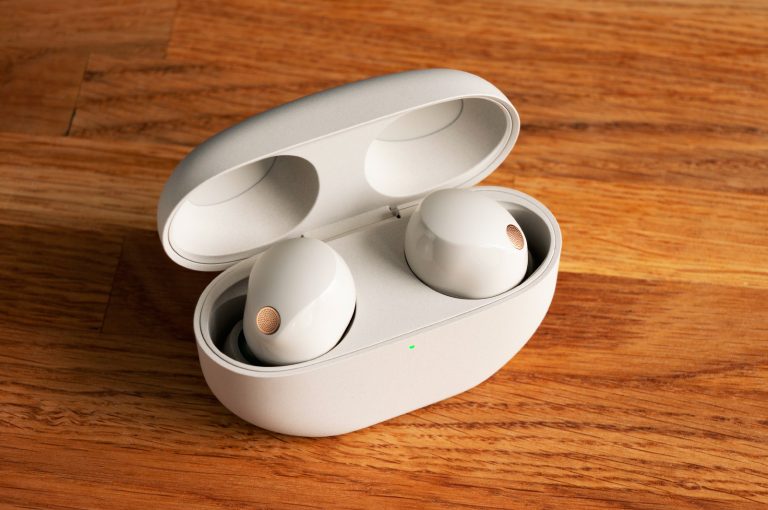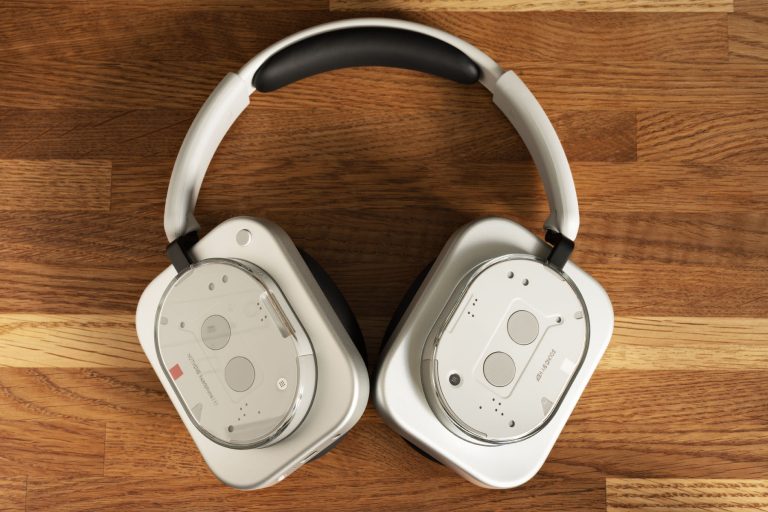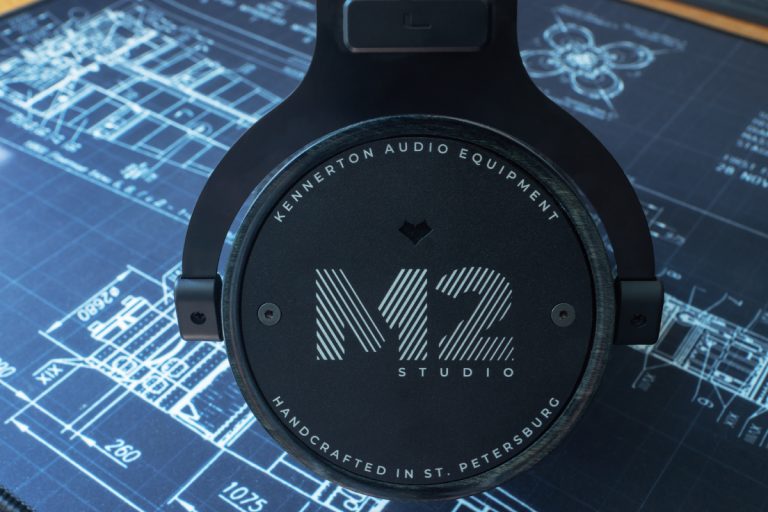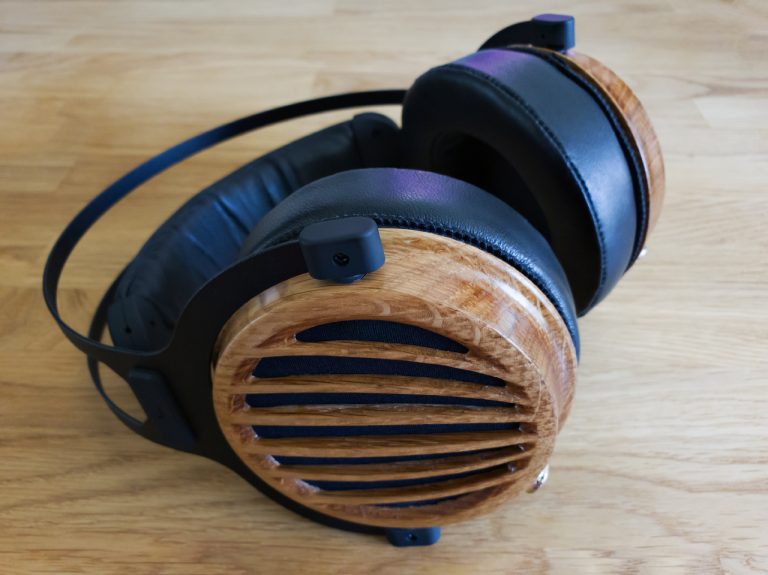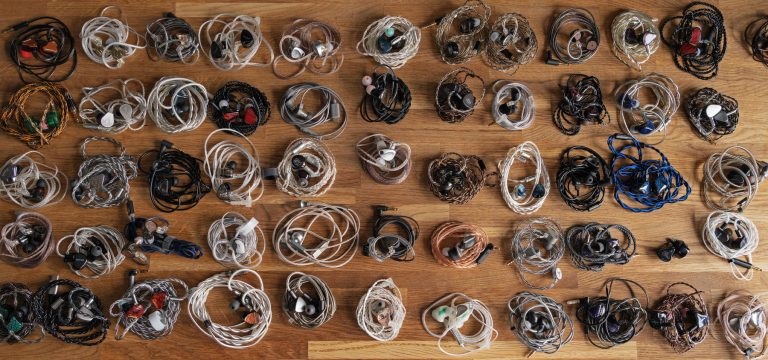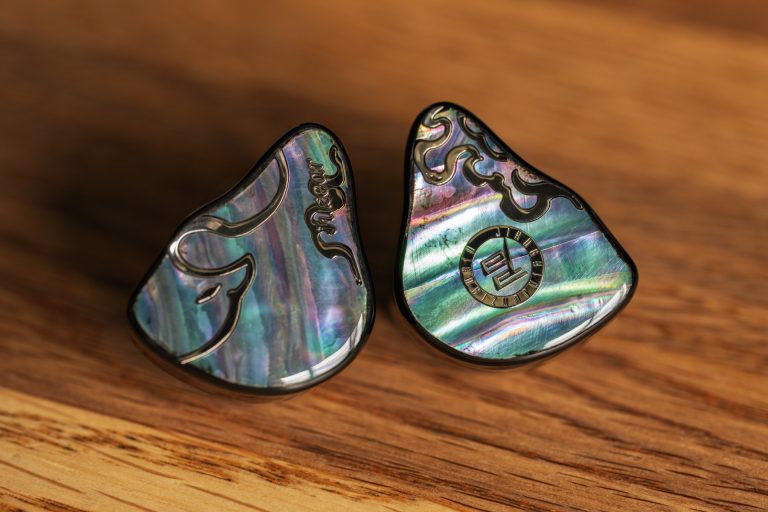About target curves, rigs, standards, neutrality and subjectivity of headphones sounding perception
This one is the 3rd theory article. I’d take a look at the first two in advance if I was you:
- About the sound in headphones and the Harman target response curve
- About headphones measurements and frequency response in particular
Introduction
As of the middle of 2022, there are several target curves (hereinafter referred to as TCs) trending – in both ‘neutral’ and ‘subjective’ camps. Naturally, for the over-ear and in-ear headphones, the TCs will be different – just because the covering headphones engage your auricle for sound transmission, and the in-ears just don’t give a damn about your auricle, okay.
For you to correctly digest the article below, please keep in mind the key idea: the neutrality of the headphones sounding is only partly a scientifically elaborated and proven concept, the rest is a convention. Yep, a convention – since even for an average ‘benchmark ear’, this concept not only doesn’t have an unambiguous definition of any sort, it’s also tightly bound to the specific listening volume.
The second thing to remember is that all the curves below are only relevant for rigs conforming to the IEC60318-4/IEC60711 standard. With other rigs, like ‘flat’ ones consisting of a cardboard sheet and a hole with a mic, like miniDSP EARS and all kinds of DIY masterpieces, these TCs will look different (or you may not be able to even measure and visualize them). What’s going to be covered in this article.
1. Trending ‘neutral’ TCs — for over-ear headphones
For the over-ear headphones, there are 3 main neutral curves to be distinguished:
The IEF Neutral target for over-ear headphones proposed by the In-Ear Fidelity website. To me personally, this TC sounds completely neutral and is a kind of ‘audiophile convention’ in terms of neutrality of headphones sounding.
All pictures in this article are clickable to enlarge.
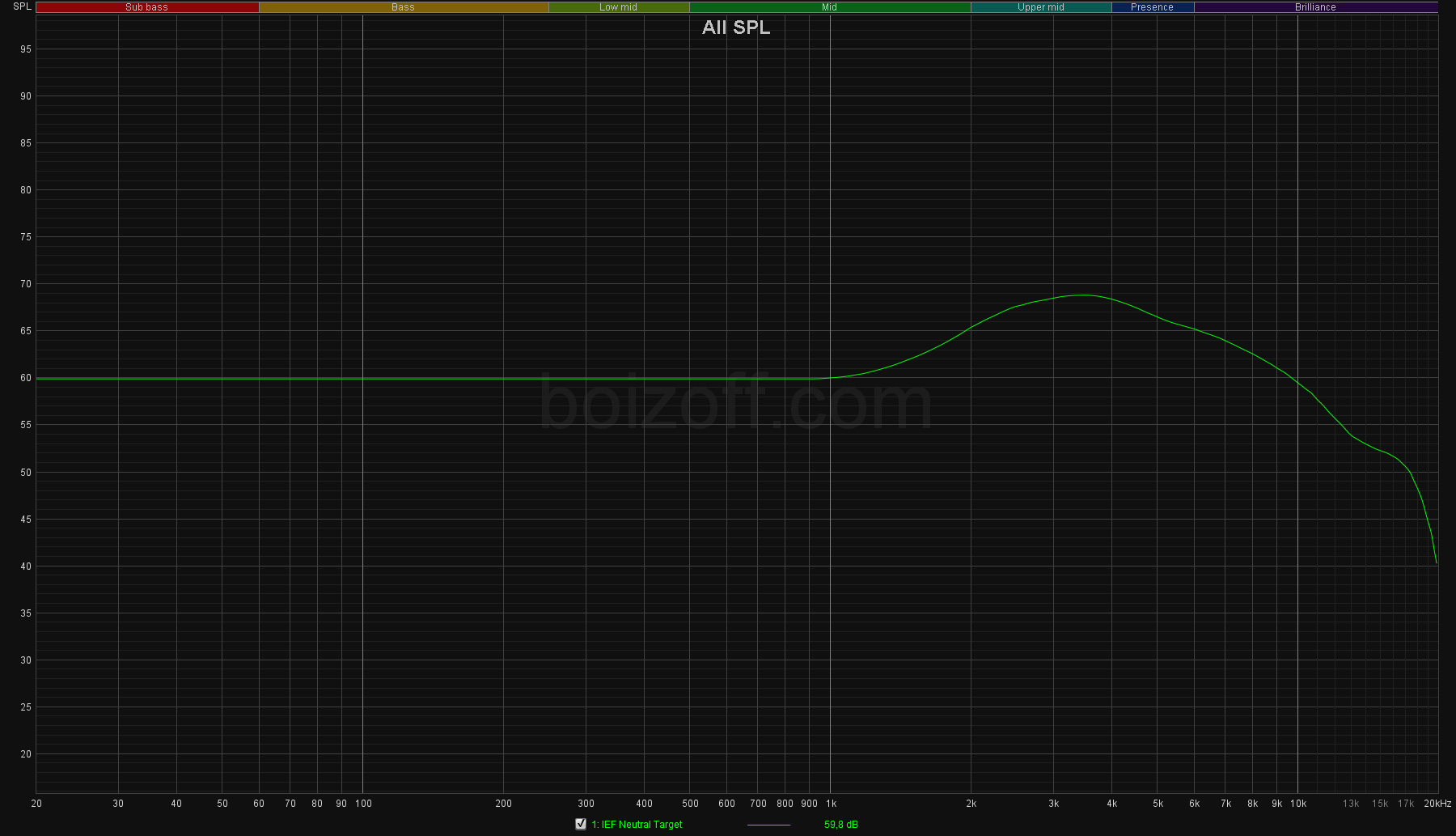
The Sonarworks target. This one is an in-built target curve of the Sonarworks Sound ID Reference software. Since Sonarworks claims their headphones setup software as intended for professional studio stuff, then the TC goes straight into the ‘neutral’ pile. Like, no questions asked. The Sonarworks rig doesn’t comply with the IEC60318-4 standard, so the TC is converted into the desired standard parameters using the headphones measurements.

The (B&K) Optimum HIFI target. Oratory1990 adapted this curve to the headphones sounding. The TC itself is a result of research made in 1974 by Bruel & Kjaer (click here for correct pronunciation; may come in handy one day in a fight with your local headphones store assistant). Here is the research (for an online fight this time).
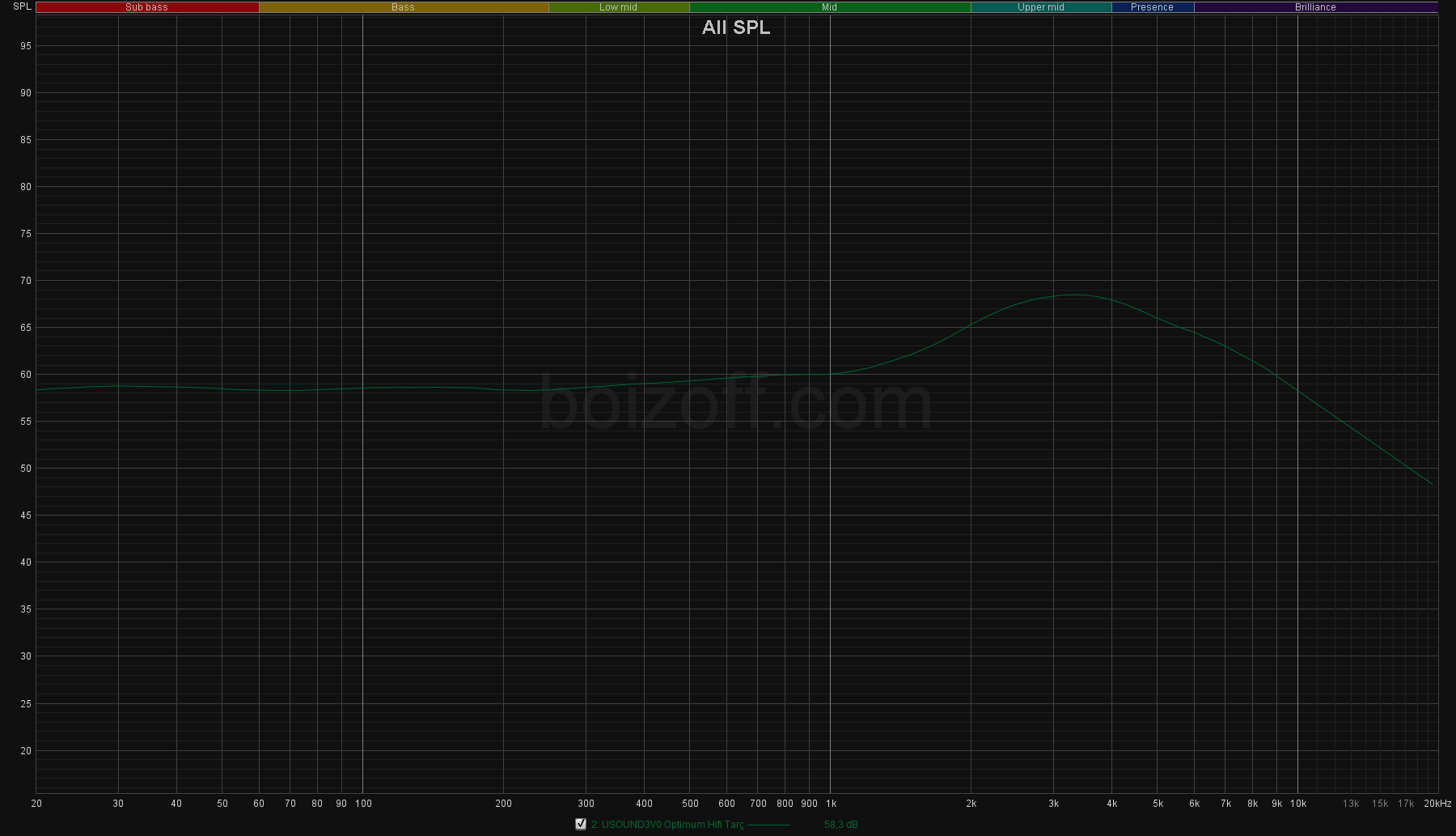
2. Trending ‘neutral’ TCs — for in-ear headphones
The IEF Neutral target for in-ear headphones. Again, suggested by the In-Ear Fidelity website in May 2020 (source). And again, for my personal taste, this TC ‘sounds’ really neutral, provided that the headphones are sound-proofed and fit snugly (as they should, thank you very much).

The Etymotictarget. It’s a rather unique TC you would use with a very deep headphone fit and a very, very good sound insulation. Here’s what the creators say: ‘Target curves on Etymotic Research graphs indicate 100% accuracy: The open ear diffuse-field response of the KEMAR® manikin modified to compensate for the high frequency boost added to high-quality recordings. This modification (approximately 5 dB at 10 kHz) is necessary to avoid earphones sounding too bright on commercial recordings. Commercial recordings have a high-frequency boost that compensates for the high frequency roll-off in studio monitor loudspeakers and high-quality stereo loudspeakers and earphones.’ (source)

3. Known ‘subjective’ TCs – for over-ear headphones
The Harman target 2018. It’s a Harman curve for over-ear headphones that appeared in 2018. This one was obtained empirically through Harman company research. For more info, click here.
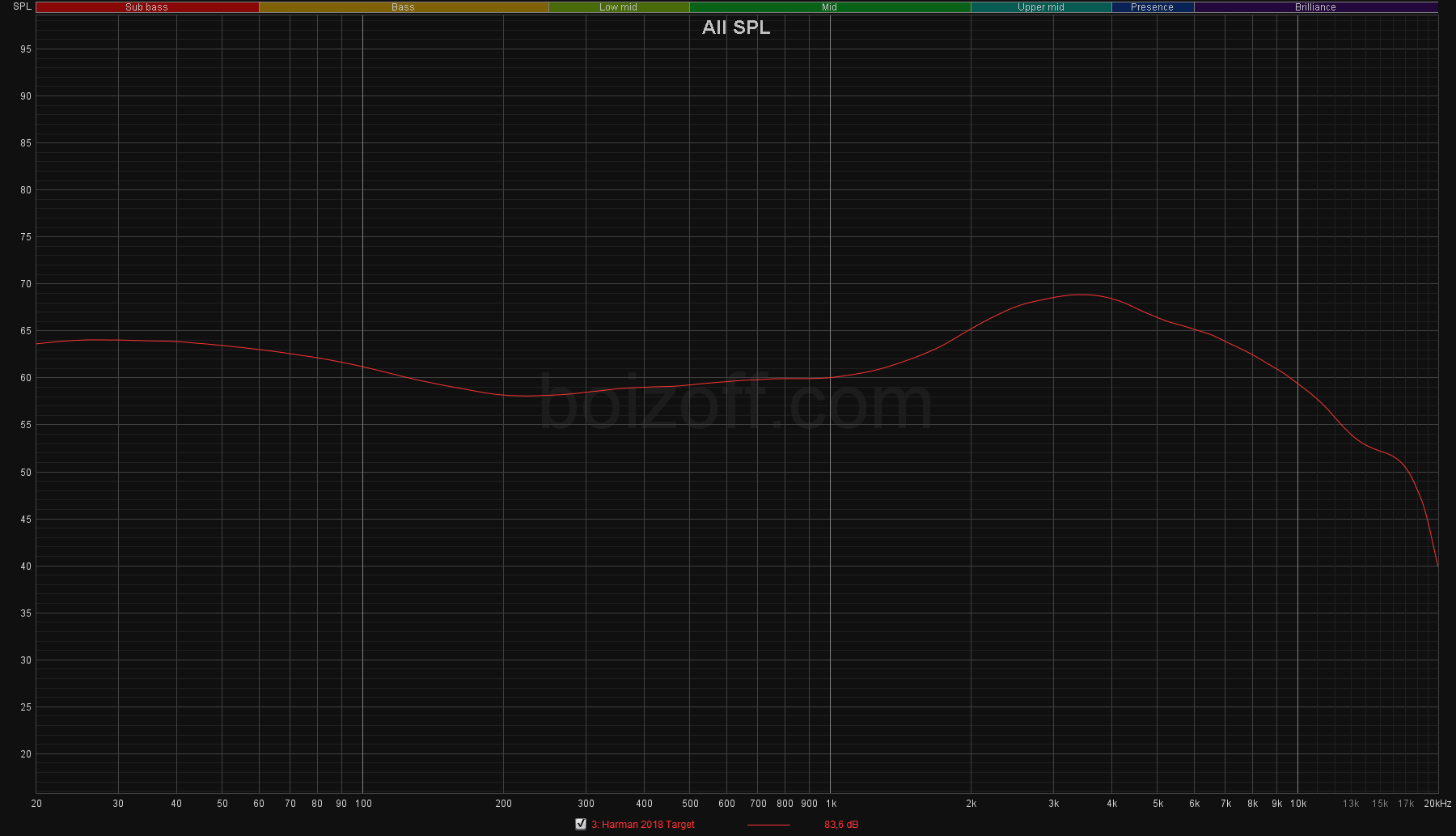
The Rtings target. It’s a curve used when testing headphones on the rtings.com website. The creators say the following: ‘The bass and mid range of our target is based on the Harman target response, and the treble of our target is based on the diffuse field response of our dummy head.’ (source) Since the rtings rig doesn’t comply with the IEC711 standard, the curve was adapted to the IEC711 parameters via headphones measurements.
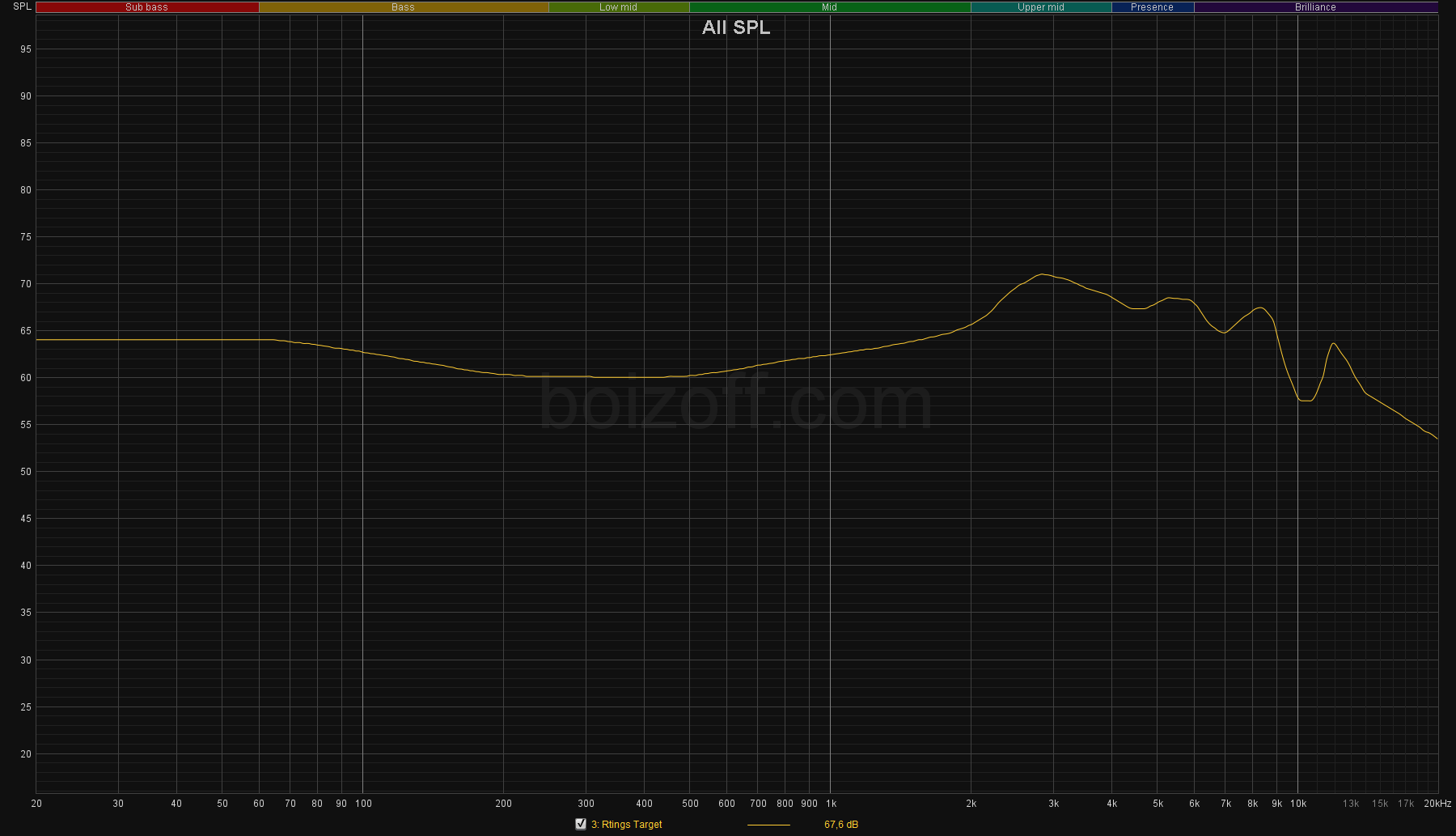
4. Known ‘subjective’ TCs – for in-ear headphones
The Harman IE 2019 v2 Target. It’s the latest version of the Harman curve for in-ear headphones.
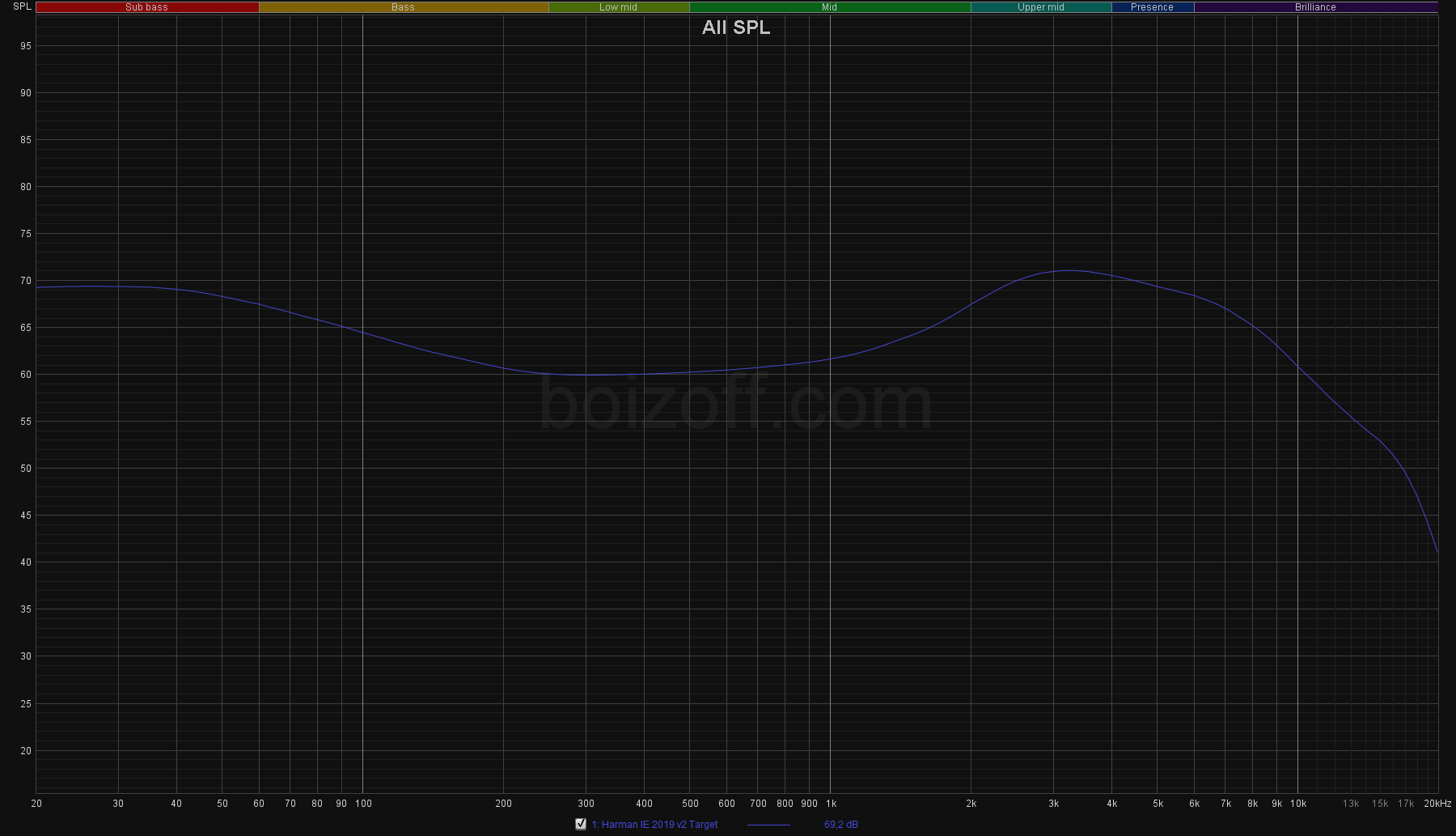
The USOUND1V1 Target. Here, the USOUND engineers took the Harman TC and tried to make it work given the noisy urban environment influence on sound perception, as well as the trending subjective preferences of users. It turned out to be pretty much… the Harman TC (surprise), but different (wow).
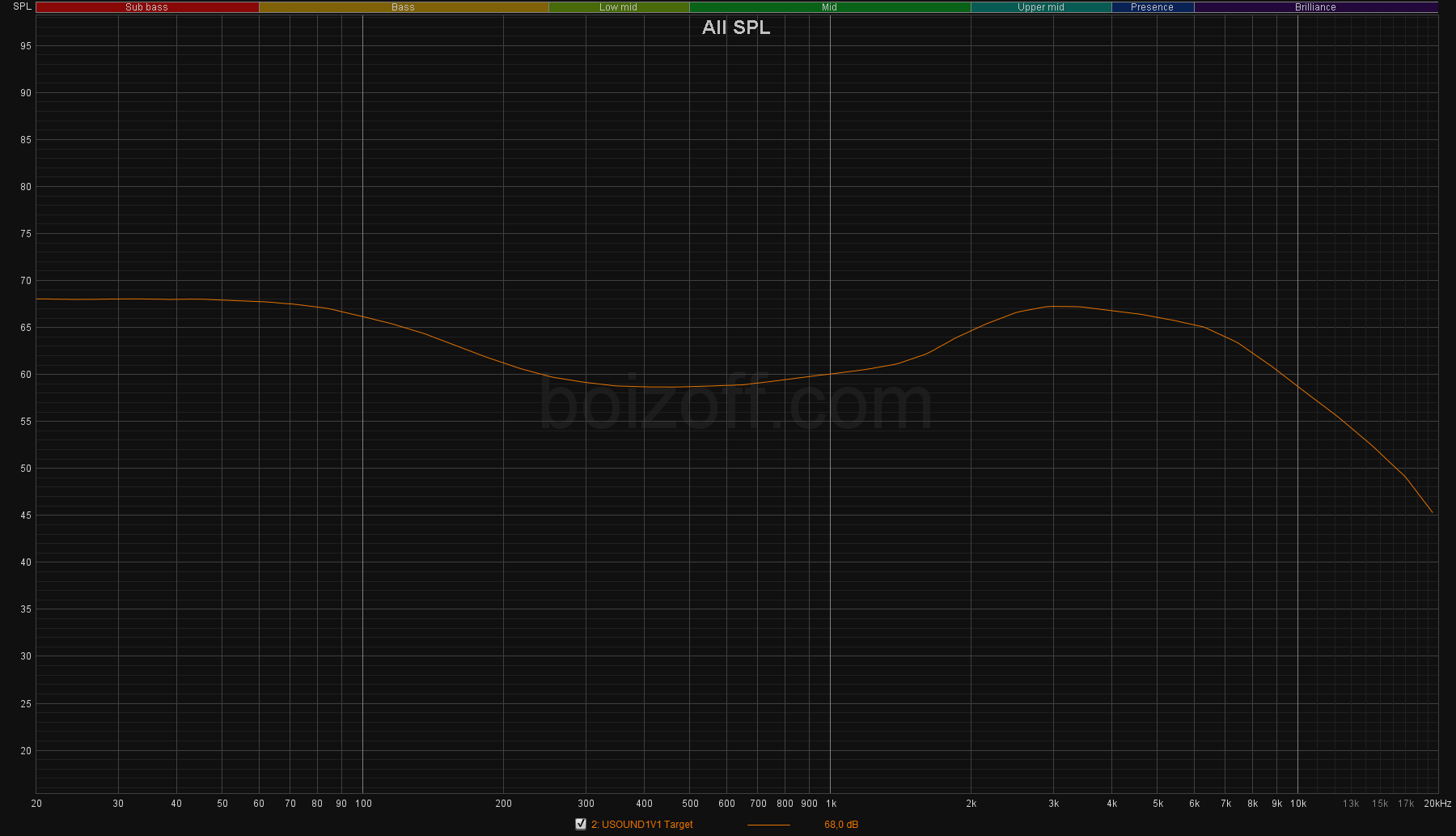
5. Why do the target curves look like this
Let’s compare the subjective and neutral TCs for different types of headphones.
For over-ear headphones:

The only thing worth noting here is that the Sonarworks curve delivers the most particular sound with a pronounced V-shaped dip, since the accents at the sub-bass section and around 2.7 kHz are the greatest compared to other options.
For in-ear headphones:
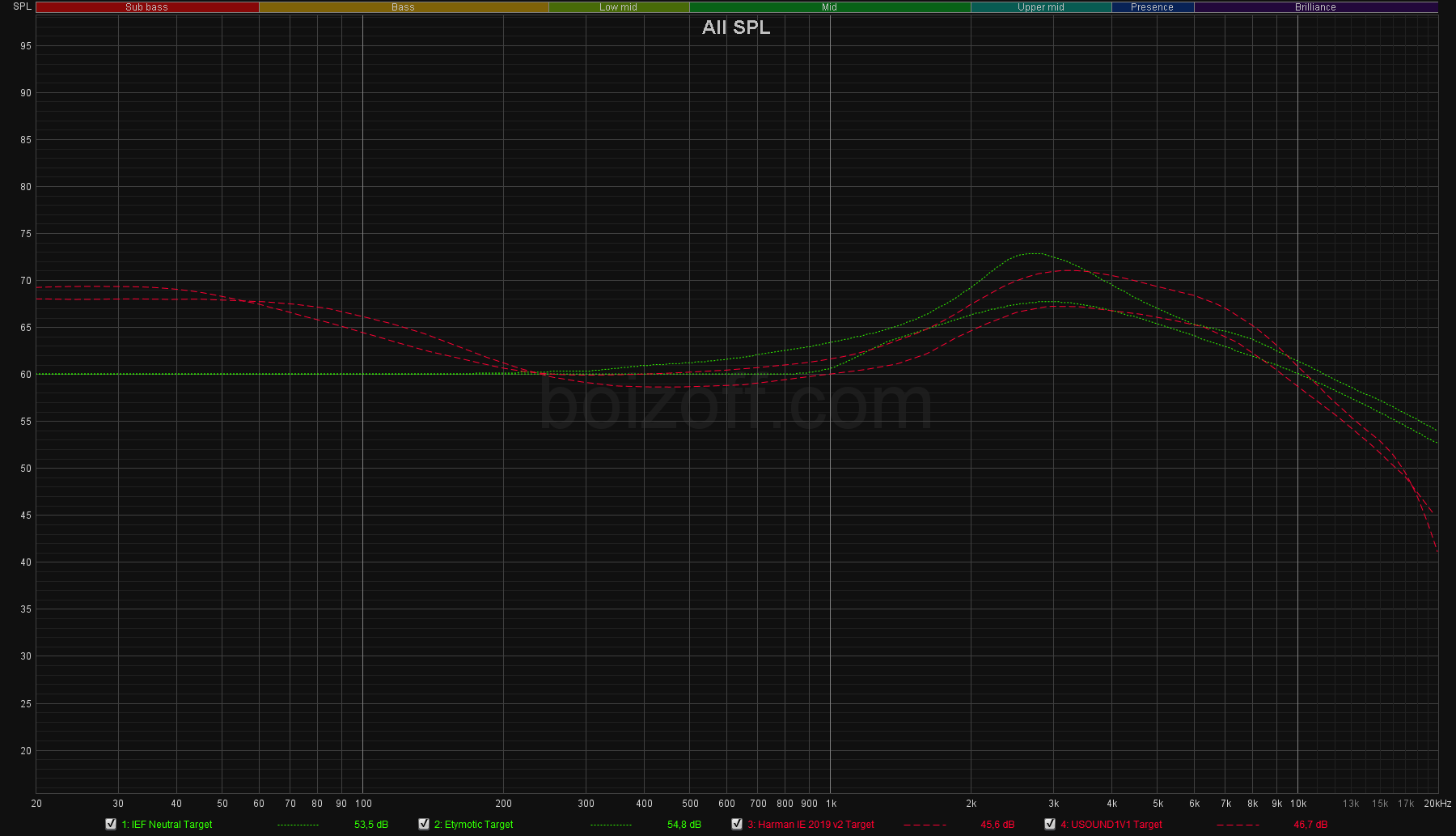
Why do you think the curves have that hump on the right anyway? It’s because if
- you take a neutrally sounding – I mean, equally loud at all frequencies – speaker,
- put it in an anechoic chamber,
- play a 20-20000 Hz range swipe tone,
- then take a dummy with ear simulators and measure the readings of microphones located at the level of the eardrums,
you’ll have this (one of the sources):
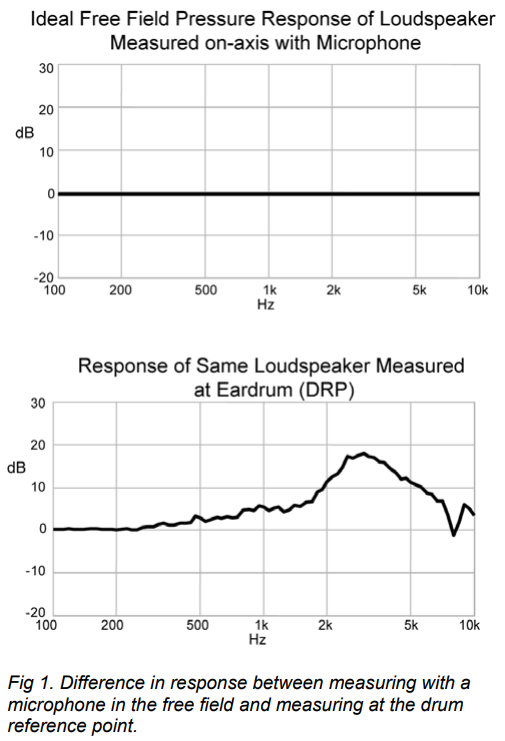
Why do different neutral curves have that hump on the right slightly different size and position? Basically, it’s because a specific position the speaker relative to the dummy can be different, a type of the field to be taken into account can be diffuse or free, as well as a few more nuances.
Why is there a rise in sub-bass and bass, pretty much specific for the ‘subjective’ TCs? There are different external factors:
- the currently trending music is being mixed for this exact type of sound delivery;
- most listeners like it better (see Harman research);
- it’s now a fact of life there’s nothing we can do but to listen to our music in the noisy urban environment including public transport: that’s because the lower frequencies are kind of filtered out and therefore need to be emphasized even more.
Are there any other target curves? Yes, a shit-ton of them. For example, for in-ear headphones:
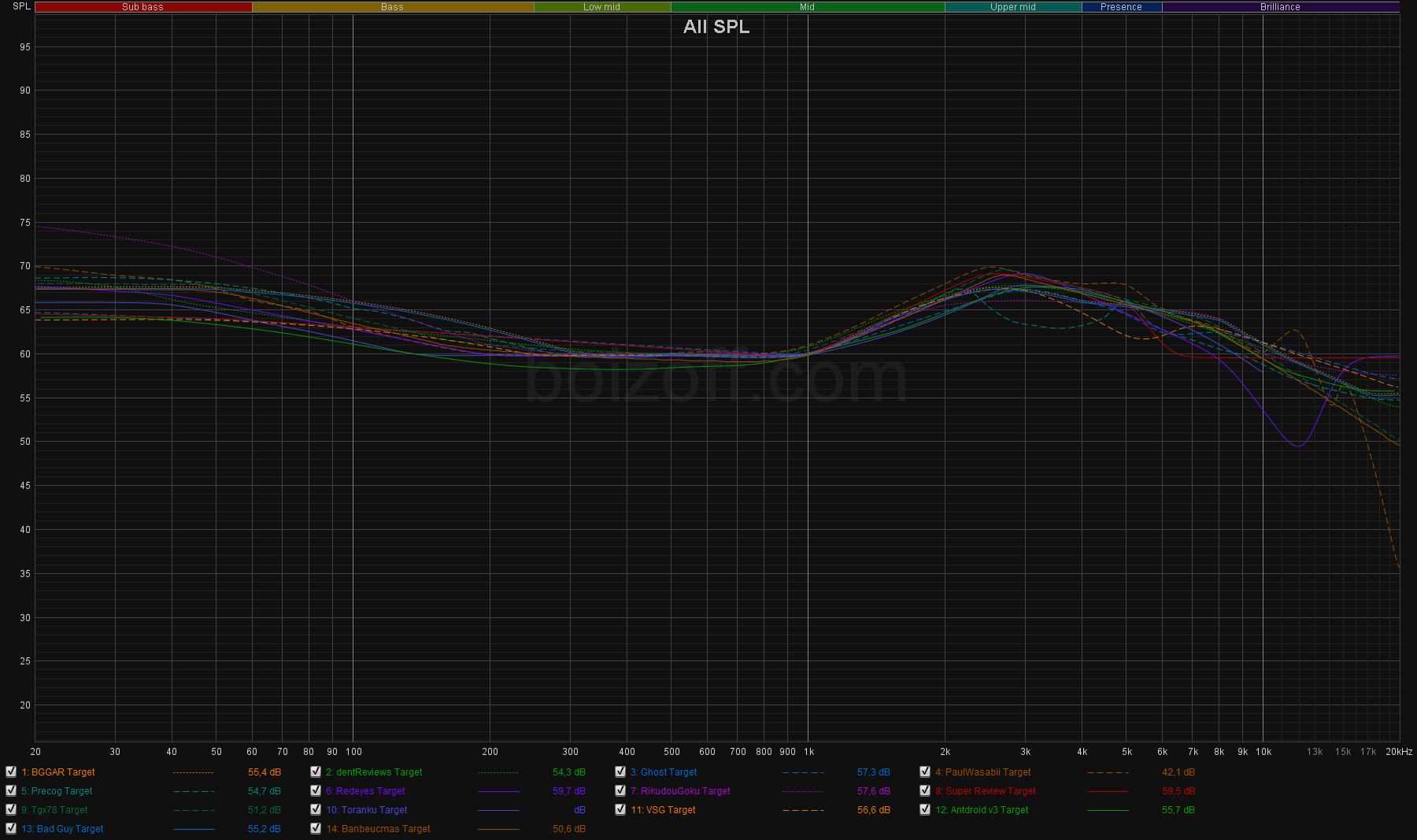
And these aren’t even all of them. If you have some time to spend, visit squig.link and browse some headphones measurement databases (you can choose them one by one in the drop-down list on the left). Either way, these all are just ‘subjective’ curves by various reviewers based on their own perception and preferences, so I don’t see much point in dwelling on them in detail. The main thing is that everyone can try and draw their own TC.
A couple of things about the rig and the target curve of the Reference Audio Analyzer website. The RAA use a kind of DIY HDM-X rig. Statistically, you can calculate a TC by comparing the measurements of headphones (source).
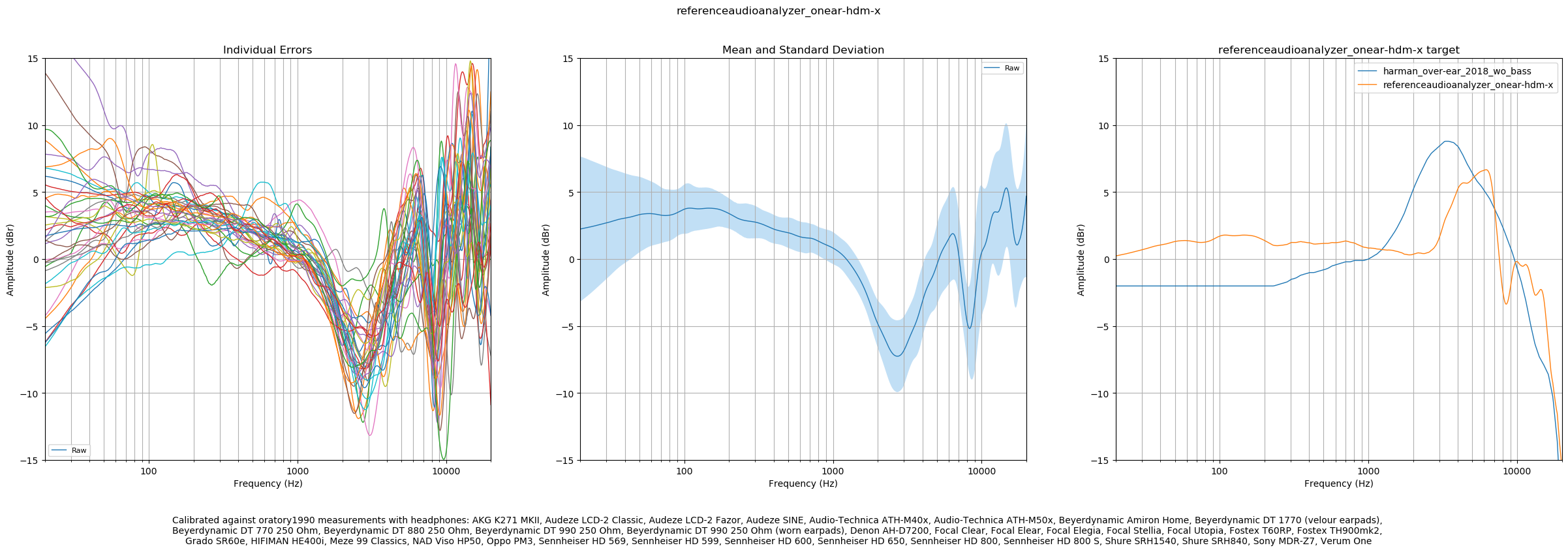
The discrepancy is very big, and this makes me think about an incorrect simulation of the human ear acoustic impedance. And, therefore, the RAA measurements are basically useless.
6. About different rigs complying with the IEC60318-4 standard
To begin with, a quick note on the standards. The international IEC60711 (or simply IEC711) standard was adopted in 1981. In 2010 it was replaced by the IEC60138-4 standard.
Key points:
- The IEC60318-4 standard applies to an inner ear simulator designed to measure head telephones with an earbud (a plug-in phone or remote phone) in the 100 to 10000 Hz frequency range.
- Over 10 kHz, the device conforming to the IEC60318-4 doesn’t simulate a human ear, but can be used as an acoustic communication device at higher frequencies – up to 16 kHz. Below 100 Hz, the device just can’t simulate a human ear for testing purposes, but can be used as an acoustic communication device at lower frequencies up to 20 Hz down. Due to resonances in the acoustic transmission impedance of the inner ear simulator at frequencies above 10 kHz, there may be a large measurement error in the phone frequency characteristics – some 10 dB of discrepancy, imagine that.
To summarize, the IEC60318-4 standard only applies to the inner ear simulator and guarantees measurement error from ± 0.6 dB (200 Hz) to ± 2.2 dB (10 kHz) in the 100–10 kHz range.
…This all was happening in 2010. And in 2016, the GRAS released the GRAS 43AG simulator.
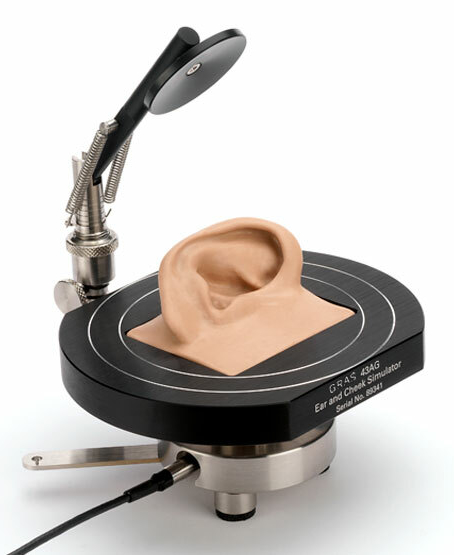
Well, actually, it’s a whole family of 7 simulator models. The most relevant for us are 43AG-3 and 43AG-4, which come bundled with rubber ears conforming to the ITU-T Rec. P.57 Type 3.3 Pinna Simulator standard. In section 5.3.3, there’s a description of the configuration and properties of the human averaged outer ear simulator. Guess what’s under these rubber ears? Inner ear simulators complying with the IEC60138-4.
A rig of this exact configuration – I mean, a simulator of the auditory canal + a rubber ear meeting the above standards – is often referred to on the Internet simply as ‘a IEC60318/IEC711 compatible rig’. It’s not correct, though. But let’s leave it this way, it just so happened, and there’s nothing we can do.
It’s important to emphasize here that the KEMAR acoustic dummy, also used by Harman and Sean Olive to measure headphones, is equipped with such ears. This is what the GRAS website says about 43AG: ‘We call it the table-top KEMAR as it offers you much of the KEMAR capability in a convenient and portable package.‘ (source)
In addition to relatively large discrepancy and a rather limited frequency range compared to human hearing, the GRAS rig has another unpleasant property. Which is its price. The GRAS don’t even publish the price on their website, but, as Google is for everyone, GRAS 43AG-4 costs about €4,500, and GRAS 43AG-7 (with an auditory canal simulator allowing measurements up to 20 kHz) costs about $7,500. The KEMAR rig costs only some $26,000, by the way. Not something you’d ask Santa for, right? And, as far as I understand, the electrical part – high-precision sources, ADC, power supply – isn’t even included.
Of course, the GRAS aren’t the only company on the market, and other manufacturers have similar devices to offer. For example, the Audio Precision AECM206 for about $11,000.
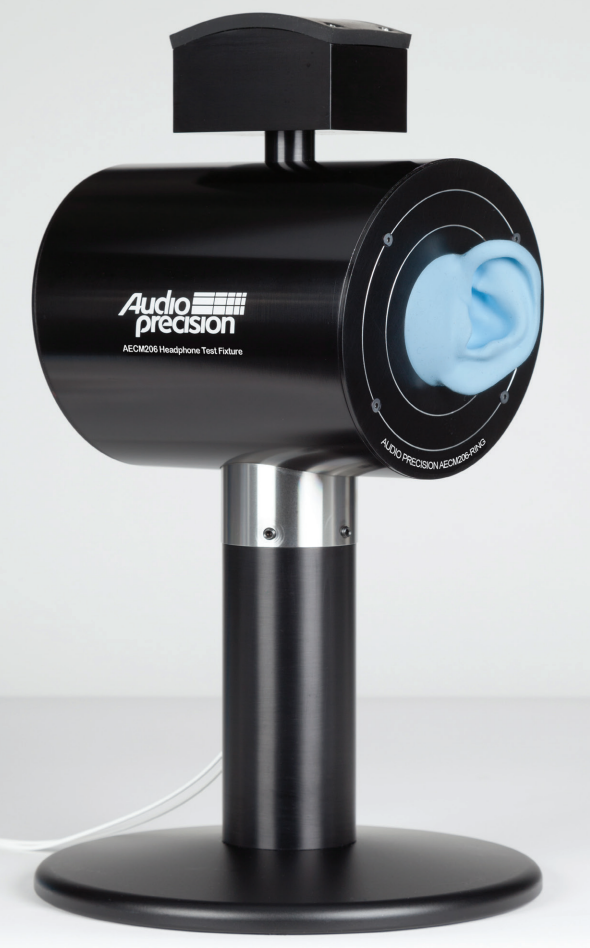
Or Bruel & Kjaer TYPE 4153 – a used one would cost you $4,000 on Ebay.
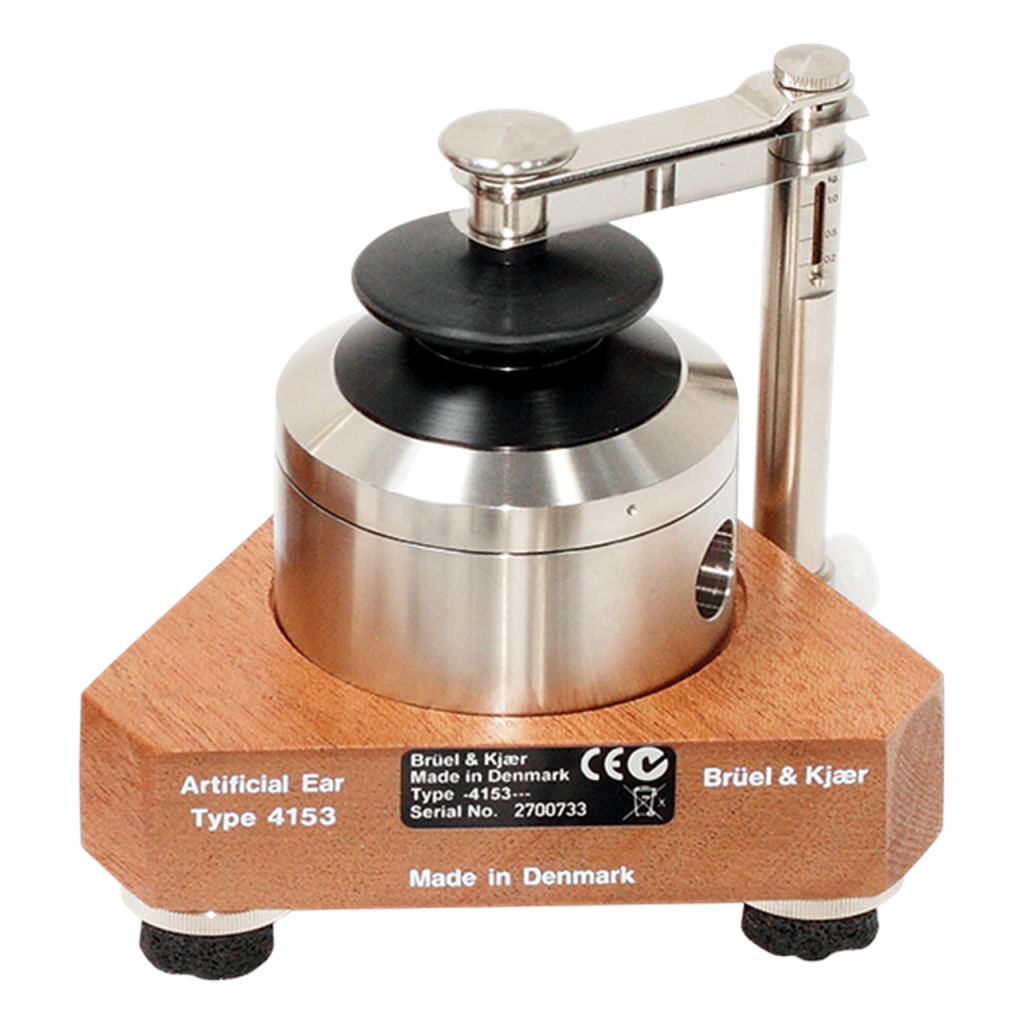
Neumann KU100. This one is in fact a mic-head for binaural recordings, but some geniuses use it to measure headphones God knows why: the measurements would be even more accurate with an old soup can. Oh yeah, this one costs around $10,000 (the rig, not the can).
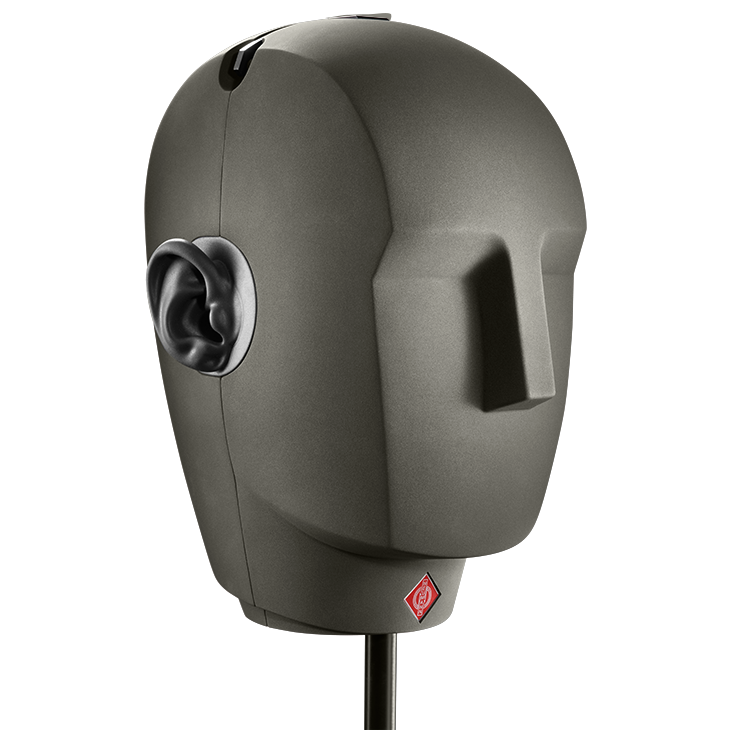
Obviously, in no competition situation on such a unique market, you can state any price. Like, any at all. Who would buy it? Headphones manufacturers, maybe, though I’m not sure all of them would. The audio-enthusiasts couldn’t even think about such toys.
Therefore, here are two more really important events.
- At the end of 2018, the Hong Kong company miniDSP released the miniDSP EARS rig designed to measure the headphones frequency response. It only costs $250, that is, compared to GRAS products, it’s just a gift of gods.
- At the end of 2020, the Chinese company Sounds Good (check out the Sounds Good Store on AliExpress) launches a very decent replica of the GRAS 43AG for only $300-400, depending on the bundle.
And this is when the game changed. But hold on – I still have a couple of things to say.
7. Better than IEC60318-4/711
The headphones measurement accuracy of ± 2.2 dB in the 100 to 10000 Hz range isn’t an exactly perfect result, right? Well, do you think it’s possible to measure better?
Yes, it is.
For example, the GRAS features an ear canal simulator RA0403/04 allowing measurements from 100 Hz to 100 kHz.
The Bruel & Kjaer are ready to help, too – back in August 2020, they’ve released the HATS (Head and Torso Simulator) – a Type 5128 rig with progressive auricle simulators (complying with the ITU-T Rec. P.57 standard) and ear canals (complying not only with the IEC60318-4, but even with the latest IEC60318-7 adopted in early 2021).
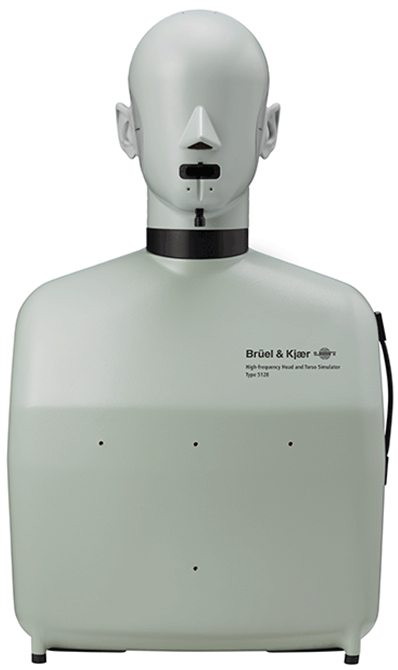
The Type 4620 ear simulators used as part of this rig are made based on the average human ear features. 40 people of different ages donated their ears for science – just joking. 40 ear casts were obtained. The mic is installed exactly at the level of the eardrum, and at a correct angle. There’s a pretty interesting video about this rig. Take a look, if you want.
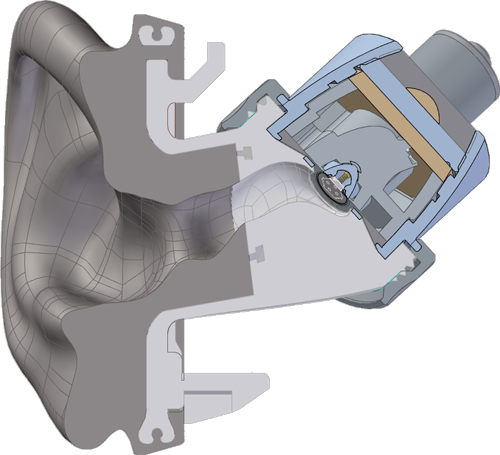
Such a rig allows measurements from actual 8 Hz to 20 kHz. And the cost is $41,000 (‘Well, nobody’s perfect’ (c)). It can be used, for example, for measurements on the soundguys.com website with their proprietary TC.
But screw that elitist stuff for rich guys. We’re just simple enthusiasts, so let’s get back to our world.
8. Comparison of over-ear headphones measurements with the miniDSP EARS rig and in IEC60318-4 terms
8.1. miniDSP EARS
Here and further, by ‘IEC60318-4 rig’ I’m going to mean a full-fledged rig meeting the IEC60318-4 standard in what’s related to the auditory canal and the ITU-T Rec. P.57 Type 3.3 standard in what’s about the auricle model.
The miniDSP EARS rig (hereinafter — just EARS) is a frame with two silicone ears, two mics facing the auditory canal, as well as an analog-to-digital converter (with 4 gain levels) allowing direct connection between the rig and the PC via USB port. This rig doesn’t meet any standards at all in any way, it doesn’t even simulate auditory canals, but it’s very convenient to use – no extras needed to perform your measurements, just a rig itself and a USB cable. Well, there’s still an inconvenience: the rig has an unnatural interaural base, that is, the distance between the ears: in an average adult person, the distance is around 21 cm, and the EARS is only 10.5 cm out to out. This greatly affects the headphones pressure, since some headphones just can’t hug such a small ‘head’ any tight. And here’s where my natural ingenuity comes in handy: I simply expanded the interaural base with DIY spacers, getting 15 cm distance between the ‘ears’, which is already enough for a tight fit of almost any over-ear headphones.
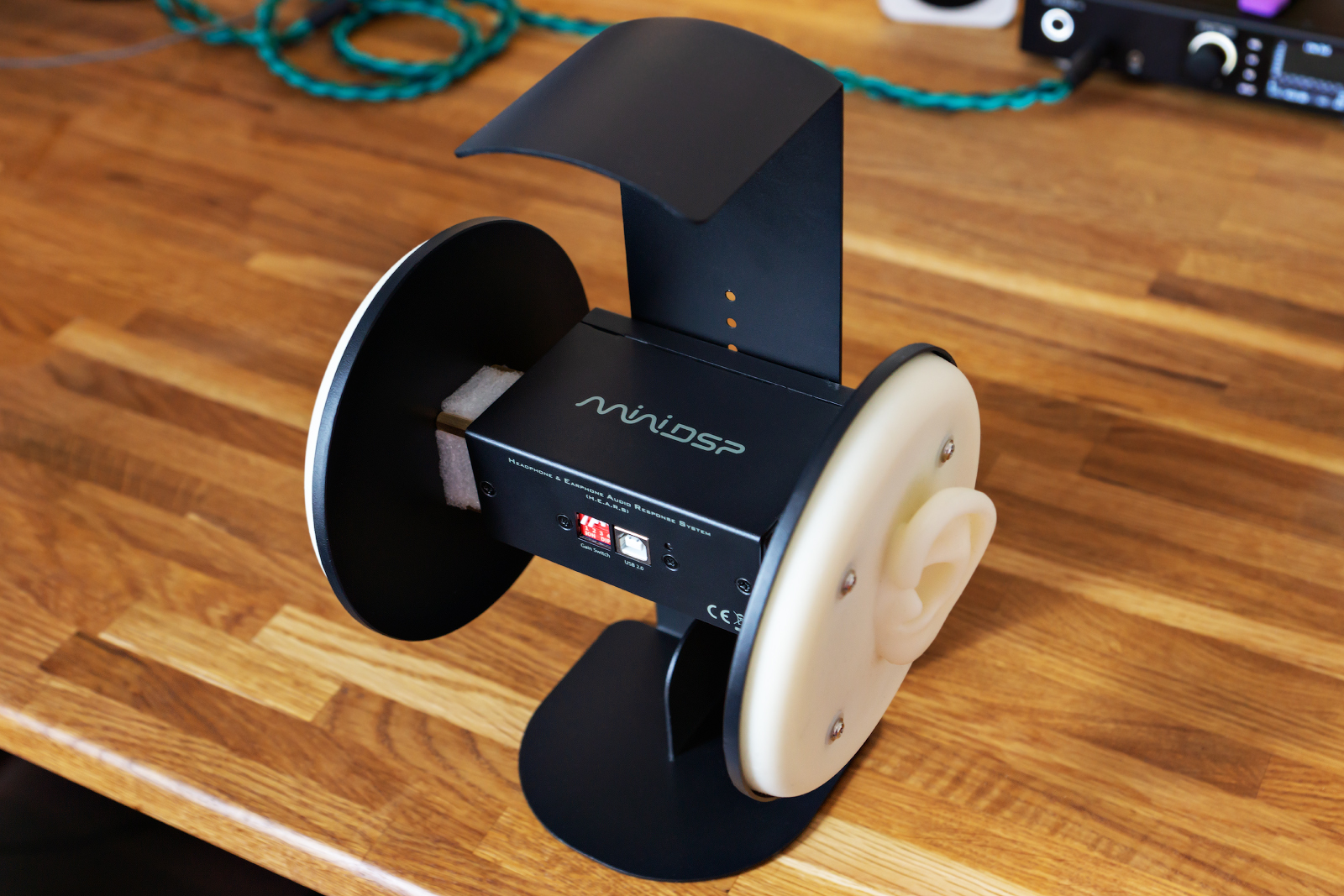
The manufacturer offers downloadable ‘calibration files’ for each rig model – and these actually work as compensation curves (hereinafter referred to as CC).
- The HEQ – Headphone EQ – is a kind of more or less ‘flat’ CC for over-ear headphones.
- The HPN – Headphone Measurements Compensation – is some other kind of CC for over-ear headphones.
- The IDF – IEM Diffuse Field Compensation – is a kind of CC for in-ear headphones, allowing evaluation of their frequency response for proximity of a diffuse field in the TC.
You can also download separate calibration files for mics – the left and the right one. I won’t bother you with all those unimportant details of the rig’s functioning and the use experience: there’s a whole lot of different reviews on this. Go on and Google it (please).
Overall, the EARS suggests that you assess the measurements in a normalized form, because, again, it doesn’t meet any standards: that is, you can’t just plop a CC of the IEC60318-4 rig on raw EARS measurements. But this is not where the problem sits…
See the measurements of the same headphones made with the EARS and the IEC60318-4 rig:
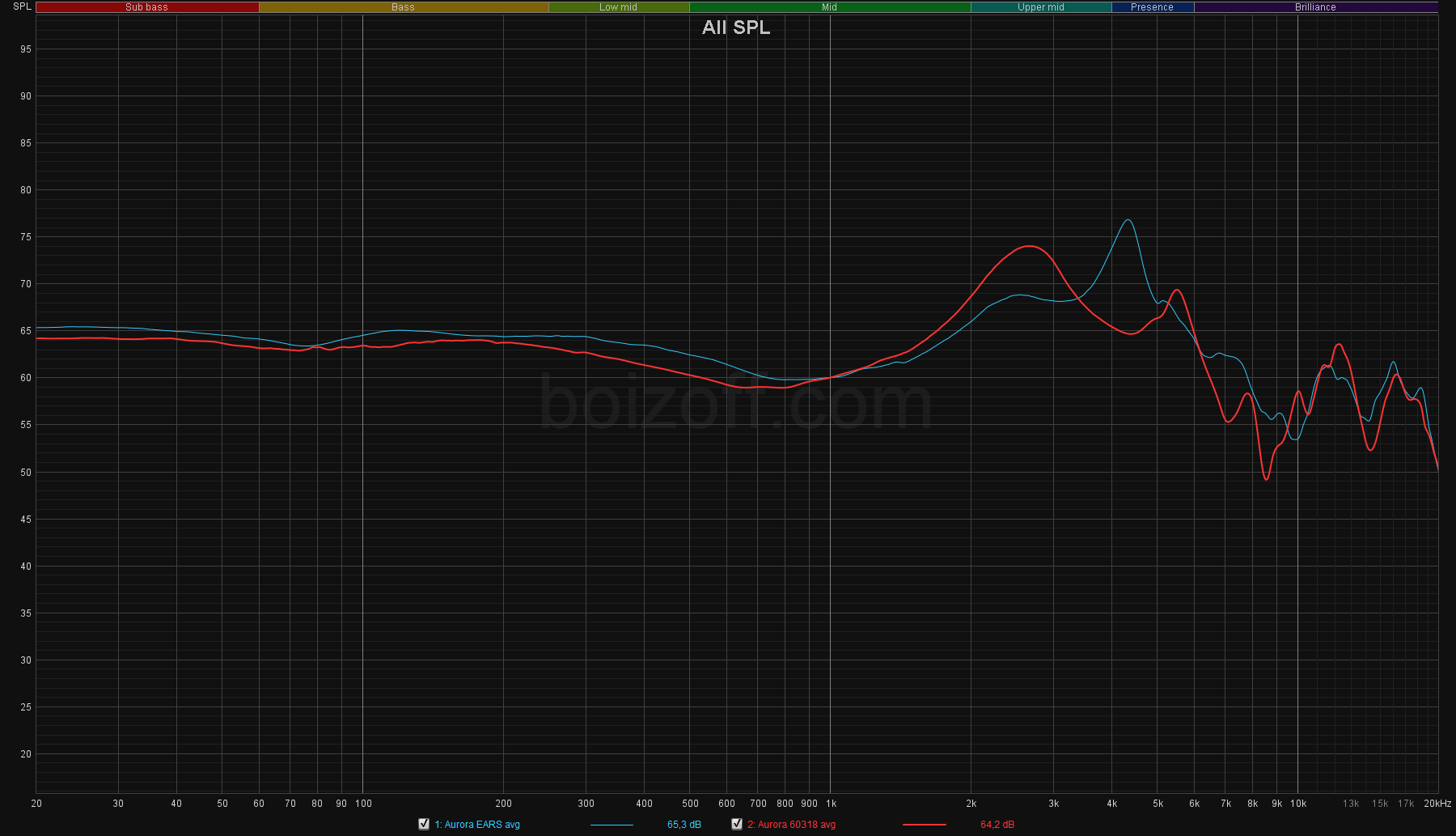
And here are the measurements of other headphones made with the EARS and the IEC60318-4 rig:

If the difference between the rig measurements was linear, then the measurements ratio of the same headphones from different rigs would always be the same. Okay, let’s divide those and compare:
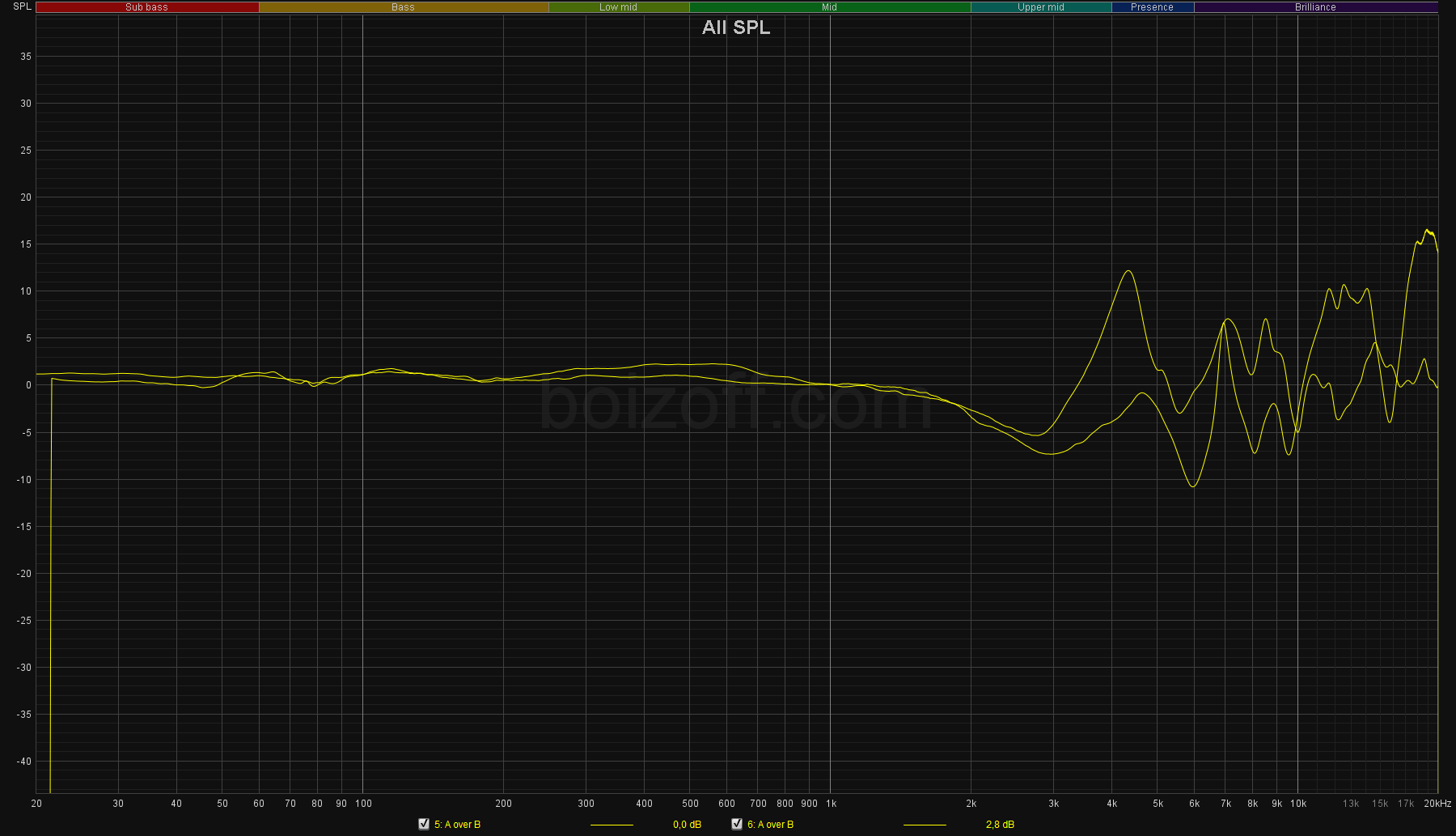
See the vertical lines on the right and left? I did it. Because I’m not Mr Perfect, okay? Well, what I want you to notice is a discrepancy in the main section of the graph, especially at 2 kHz and above. Unfortunately, the EARS distort measurements non-linearly due to their incorrect acoustic resistance, so it’ll never be possible to compare these measurements with any fixed curve – with EARS, for each specific headphone model, you’ll have to look for your own separate curve (identical to the same curve for the IEC711 rig). It can be possible to somehow average the rig distortion by comparing measurements of a large number of different headphones and get a version able to achieve some results, but still with a big random discrepancy.
Here’s what we’ll have (credits to Oratory1990): the gray area is about the potential deviations, the magnitude of which depends on a specific pair of headphones.
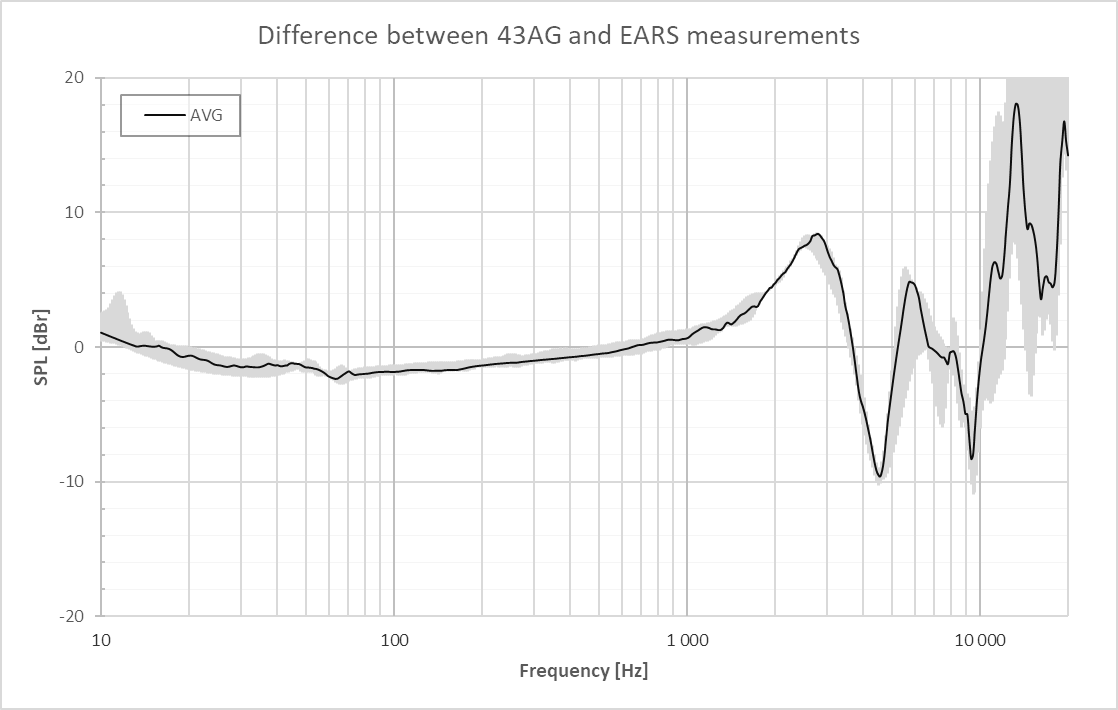
To some extent, the value range in the bass and sub-bass sections can be narrowed if you extract the screws holding the silicone ears: this is going to increase the pressure of the earpads. Though it won’t radically change the situation. Up to 4 kHz, the measurements are more or less stable, but then hell begins.
I’ve spent a million years and a large amount of self-control to elaborate my own calibration curve for EARS conforming to the IEF Neutral. I’ve tried more than 30 pairs of headphones and measurements from them, but couldn’t achieve any credible result. As far as I know, the SuperbestAudiofriends guys tried to get a similar result, too, but gave up in the end.
That’s when I decided to switch to the GRAS 43AG replica.
8.2. The Chinese IEC60318-4 rig (GRAS AG43 replica)
I bought the following kit from the Chinese seller:
- An auditory canal simulator on a stand.
- A plate with a (left) rubber ear. Their rubber ear has a Shore hardness of A20, whereas the original GRAS KB5000 Anthropometric Pinna are 35 OO hard, that is, almost twice as soft. What I mean is that with the earpads of the headphones pressed, this A20 ear won’t deform in the same way as the original one. Nevertheless, according to the T-REC P.57 standard, a simplified version of the rubber ear should have an A20 hardness. Success!
- A separate right rubber ear.
- A compact USB sound card. It’s just a tiny device based on an old CM6206-LX rig with obviously modified circuitry. Nothing less, nothing more. It also has a microphone input and is compatible with Windows 10 without any additional drivers, thank you very much. The only thing I wanted this card for is to ensure the mobility of the rig in the very beginning. I’ll tell you what can be used as a replacement in the next part.
There are 2 essential cables (USB to miniUSB and BNC to 3.5 jack) included, too, and an adapter for the auditory canal simulator to fit the in-ear headphones in. The most valuable and fragile parts come in small plastic micro-cases with foam lining. The overall rig weight with simulator, plate and ear is 800 gr. Not bad. Every component is just perfectly designed and assembled. For any additional software, as well as the calibration file for the mic, contact the seller, and they’ll send it to you with no questions asked.
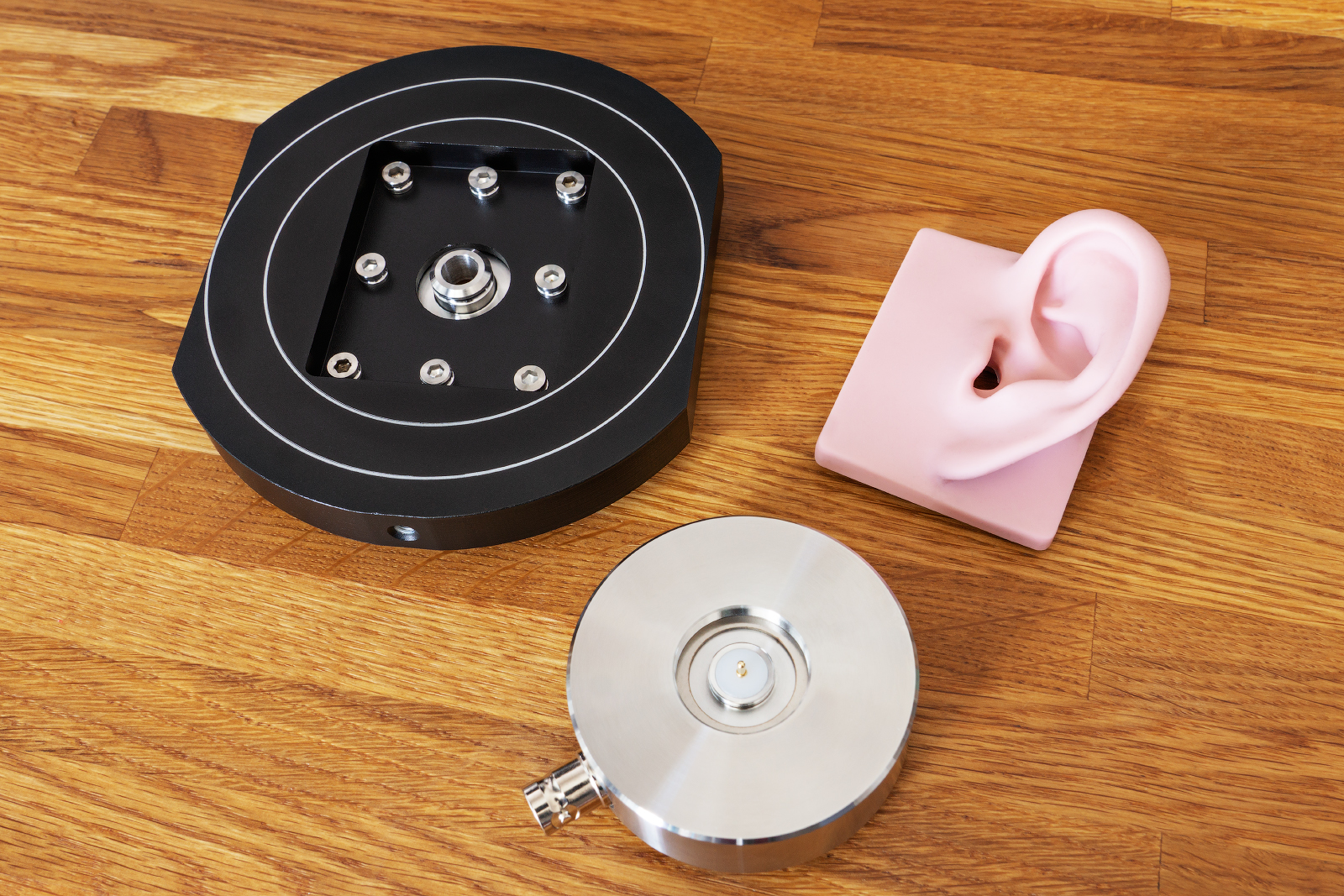
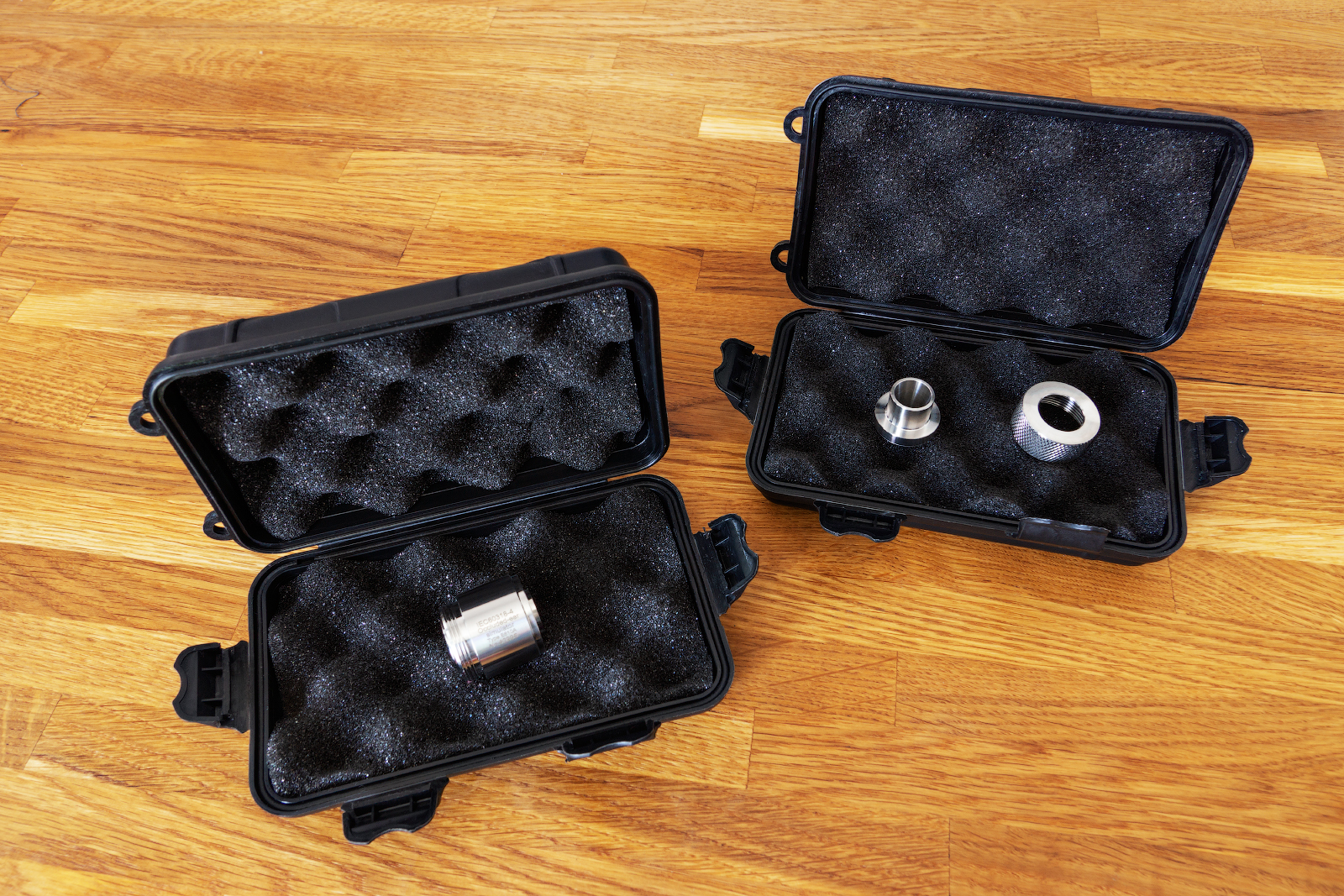
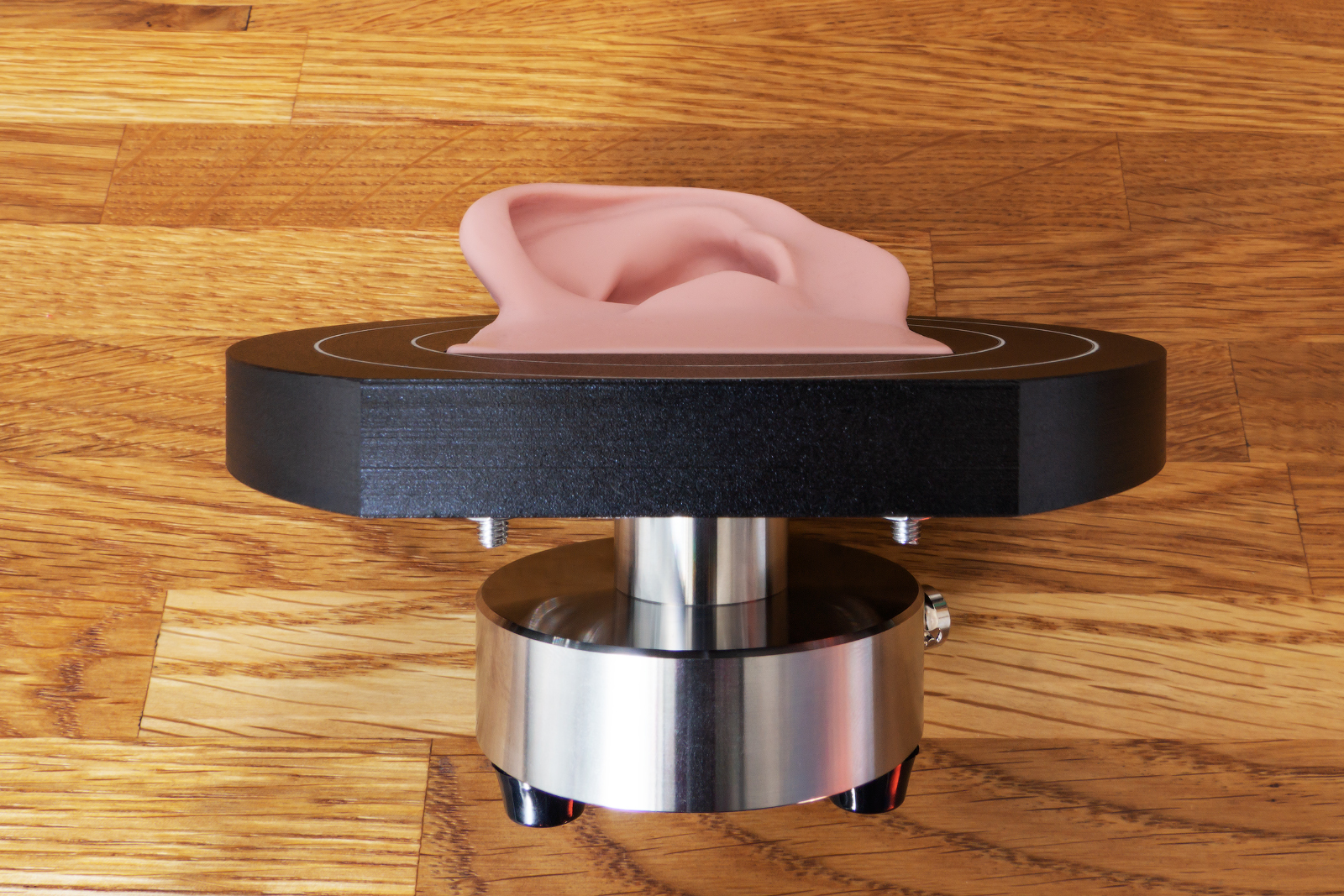
Okay, now to the practical part. And the first burning question is: how similar are the left and right ears in terms of measurements? Of course, if the earpiece driver is located coaxially relative to the auditory canal, as well as perpendicular to the plane of the rig, then both right and left earpieces can be measured with the same rubber ear. However, there’s an assload of headphones with the driver located at some angle. For example, in Sony WH-1000xmX, Sennheiser HD8X0Y, etc. And these bastards won’t let you whip up your measurements without the other ear. Let’s compare the measurements of the same earpiece made with the left and right rubber ears:
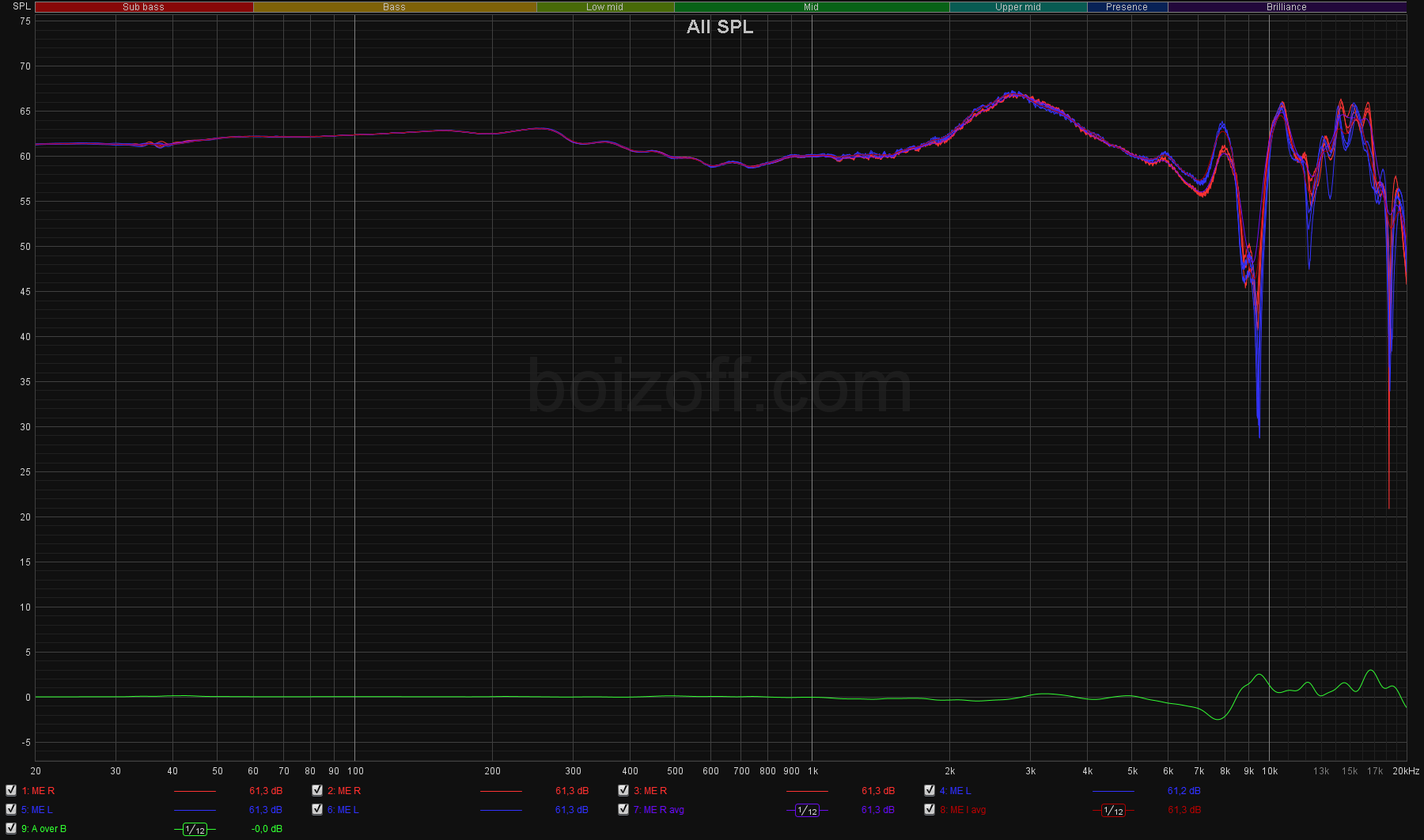
The upper part of the picture shows 3 measurements of the same earpiece made with the left and the right rubber ears. At the bottom, the green graph is the difference between the average values for the left and the right ears. As you can see, it’s almost a straight line, which is quite amazing considering that it’s virtually impossible to fit the earpiece in different ears in exactly the same way. The left and the right ears, as you can tell by now, have an identical or almost identical effect on the sound, and that’s awesome.
The second big question we can now correctly ask and correctly answer: how close is the replica rig to the original GRAS 43AG? I’ll tell you about this and other important things in my next article (gotcha!). In that same next article, I’ll also cover the topic of what’s exciting (and not really) about making measurements of in-ear and over-ear headphones with this rig. Spoiler alert: the measurements you get from the replica and the original GRAS43 rig are very, very close – the difference between them isn’t greater than the discrepancy between different instances of headphones.
My point is that now I can safely compare target curves with the measurements obtained directly, without any conversions and recalculations. Any doubts about the coherence of the measurement results are in the past, too. The Chinese GRAS43 replica is just great, and in one of my following posts I’ll share the most intimate moments about the two of us.
9. Dry answers to questions and remarks from shitheads of all kinds
Why are measurements important if my ear is not made of rubber and doesn’t even look like a standard one?
Because measurements objectively characterize the sound of the headphones themselves, not how you personally perceive them. A rig made with an eye on a standard, as well as target curves, are a measurement technique and a benchmark to assess the sounding of your headphones. Whether they suit you personally or not is a different topic having nothing to do with the methodology and the benchmark figures. Just don’t mix the two different universes.
I don’t believe in measurements, I only believe my own ears!
Imagine… Lol. Well, anyway. Imagine, you have an utterly unique ass (which is probably true). But when you need a new pair of jeans, you don’t try any jeans you can see and the store has in stock, right? You most certainly know your size and will only try jeans of that size. Even though each jeans size is designed for an average ass, and your ass is unique.
I still like X headphones better, even though they’re bad in terms of measurements!
And that’s fine, because the supreme goal of choosing, buying and using headphones is to enjoy music. The frequency response measurements have nothing to do with how much pleasure will Mr Dickson personally get from listening to model X. Remember, the measurements are about objective figures and evaluation of the headphones sounding.
Do good headphones must necessarily be neutral?
There’s nothing the headphones must be. Having
- an idea about the frequency response of a particular model in comparison with a target curve,
- the ability to compare measurements of different models, because the measurements are standard,
- an idea of your own preferences in sound,
the buyer can make a more or less informed decision on the headphones model (in terms of sound only, of course) without any help from reviewers with their stupid terms.
As for the closeness to any TC, the only thing to be stated with a high degree of certainty is that a large number of headphones models, the sounding of which is regarded by a significant number of users as very good, are either close to some basic TC, or deviate from it (1) a bit or (2) very smoothly.
Okay, there are X headphones, they cost a hundred thousand billion dollars, but the measurements are bad: does it mean the headphones’ manufacturer, a well-known company X, fucked up?
It only means that the well-known manufacturer of headphones X has, as always, its own specific goal – to sell more of its headphones. To be honest, the sales don’t correlate with the headphones tuning: there are lots of well-selling models with disgusting sounding. For example, Beats, Master&Dynamic farts, some of the Audeze models. People are more than happy to pay for trendy stuff, esoteric charge, ‘nanotech’, ‘metamaterials’, uncommon design and other (relative to sound) really important parameters such as comfort or battery time.
See, the headphones have other important parameters, not only the frequency response!
No, the headphones sounding — doesn’t really have any other important parameters in 99.99% of cases. And you just don’t think that ‘frequency response is simple’, and an insignificant difference in frequency response between some two models makes their sounding similar. I repeat, headphones have a lot of other features: comfort, fit, reliability, weight, etc, which actually ARE important.
Looks like if you adjust the frequency response of some headphones to the sound of other headphones using the equalizer, then the headphones will sound exactly the same?
Yep, if you correctly understand the task of equalizing the headphones itself.

